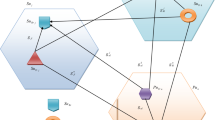Abstract
This paper investigates the problem of optimal scheduling for cognitive radio network links in order to maximize the aggregated cognitive radio network throughput. The problem is formulated as an integer linear programming (ILP) problem, which schedules cognitive radio links to maximize the aggregated network throughput subject to primary and cognitive network protection. The proposed model is capable of scheduling multiple concurrent cognitive radio links which can coexist with a set of primary links. This approach can significantly increase the aggregated network throughput and utilize the spectrum more efficiently by utilizing user location information. The ILP problem is optimally solved for specific network scenarios and numerical results are presented.



Similar content being viewed by others
References
Yonghong Zhang, C. L. (2009). Cross-layer resource allocation for real-time services in ofdm-based cognitive radio systems. Telecommunication Systems, 42(1–2), 97–108.
FCC (2003). Et Docket No 03–322 Notice of Proposed Rule Making and Order.
Akyidliz, I. F. (2008). A survey on spectrum management in cognitive radio network. IEEE Communication Magazine, 46(4), 40–48.
Hwang, Gang Uk, & Ishizaki, F. (2010). Packet level performance analysis of a packet scheduler exploiting multiuser diversity. Telecommunication Systems, 45(2–3), 249–258.
Haykin, S. (2005). Cognitive radio: Brain-empowered wireless communications. IEEE Journal on Selected Areas in Communications, 23(2), 201–220. doi:10.1109/JSAC.2004.839380.
Wang, B., & Liu, K. (2011). Advances in cognitive radio networks: A survey. IEEE Journal of Selected Topics in Signal Processing, 5(1), 5–23. doi:10.1109/JSTSP.2010.2093210.
Zhou, L., Wang, H., Lian, S., Zhang, Y., Vasilakos, A., & Jing, W. (2011). Availability-aware multimedia scheduling in heterogeneous wireless networks. IEEE Transactions on Vehicular Technology, 60(3), 1161–1170. doi:10.1109/TVT.2011.2104420.
Zhou, L., Wang, X., Tu, W., Muntean, G. M., & Geller, B. (2010). Distributed scheduling scheme for video streaming over multi-channel multi-radio multi-hop wireless networks. IEEE Journal on Selected Areas in Communications, 28(3), 409–419. doi:10.1109/JSAC.2010.100412.
Shi, Y., Hou, Y., & Zhou, H. (2009). Per-node based optimal power control for multi-hop cognitive radio networks. IEEE Transactions on Wireless Communications, 8(10), 5290–5299. doi:10.1109/TWC.2009.081702.
Thoppian, M., Venkatesan, S., Prakash, R., & Chandrasekaran, R. (2006). Mac-layer scheduling in cognitive radio based multi-hop wireless networks. In WoWMoM 2006. International symposium on a world of wireless, mobile and multimedia networks, 2006 (pp. 10–202). doi:10.1109/WOWMOM.2006.55.
Srinivasa, S., & Jafar, S. (2007). Cognitive radios for dynamic spectrum access - the throughput potential of cognitive radio: A theoretical perspective. Communications Magazine, IEEE, 45(5), 73–79. doi:10.1109/MCOM.2007.358852.
Khalil, K., Karaca, M., Ercetin, O., & Ekici, E. (2011). Optimal scheduling in cooperate-to-join cognitive radio networks. In INFOCOM, 2011 proceedings IEEE (pp. 3002–3010). doi:10.1109/INFCOM.2011.5935142.
Mitola III, J. Cognitive radio an integrated agent architecture for software defined radio (Doctoral dissertation). Retrieved from Royal Institute of Technology (KTH) website.
Ma, L., Han, X., & Shen, C.C. (2005). Dynamic open spectrum sharing mac protocol for wireless ad hoc networks. In First IEEE international symposium on New Frontiers in dynamic spectrum access networks, 2005. DySPAN 2005 (pp. 203–213). doi:10.1109/DYSPAN.2005.1542636.
Su, H., & Zhang, X. (2008). Cross-layer based opportunistic mac protocols for qos provisionings over cognitive radio wireless networks. IEEE Journal on Selected Areas in Communications, 26(1), 118–129. doi:10.1109/JSAC.2008.080111.
Urgaonkar, R., & Neely, M. (2009). Opportunistic scheduling with reliability guarantees in cognitive radio networks. IEEE Transactions on Mobile Computing, 8(6), 766–777. doi:10.1109/TMC.2009.38.
De Domenico, A., Calvanese Strinati, E., & Di Benedetto, M. (2010) A survey on mac strategies for cognitive radio networks. Communications Surveys Tutorials, IEEE (99), 1–24. doi:10.1109/SURV.2011.111510.00108.
Celebi, H. (2008). Location awareness in cognitive radio networks. University of South Florida.
Wang, L. C., & Chen, A. (2009). Effects of location awareness on concurrent transmissions for cognitive ad hoc networks overlaying infrastructure-based systems. IEEE Transactions on Mobile Computing, 8(5), 577–589. doi:10.1109/TMC.2008.72.
Chowdhury, K., & Akyildiz, I. (2008). Cognitive wireless mesh networks with dynamic spectrum access. IEEE Journal on Selected Areas in Communications, 26(1), 168–181. doi:10.1109/JSAC.2008.080115.
Song, Y., & Xie, J. (2009). Optimal power control for concurrent transmissions of location-aware mobile cognitive radio ad hoc networks. In GLOBECOM 2009. IEEE, global telecommunications conference, 2009 (pp. 1–6). doi:10.1109/GLOCOM.2009.5425877.
Nguyen, M. V., & Lee, H. S. (2011). Effective scheduling in infrastructure-based cognitive radio networks. IEEE Transactions on Mobile Computing, 10(6), 853–867. doi:10.1109/TMC.2010.224.
Hassan, M., Karmakar, G., & Kamruzzaman, J. (2011). Maximizing the concurrent transmissions in cognitive radio ad hoc networks. In 7th international wireless communications and mobile computing conference (IWCMC) (pp. 466–471). doi:10.1109/IWCMC.2011.5982578.
Hubert, M. (2004). Theory and applications of recent robust methods. Statistics for industry and technology. Basel: Birkhäuser.
Nelson, J., & Gupta, M. (2007). An em technique for multiple transmitter localization. In CISS ’07. 41st annual conference on information sciences and systems, 2007 (pp. 610–615). doi:10.1109/CISS.2007.4298380.
Ibm ilog cplex optimizer. http://www-01.ibm.com/software/integration/optimization/cplex.
Acknowledgments
This research were funded in part by the National University of Singapore under grant R-263-000-579-112, National Natural Science Foundation of China (Nos. 60902053, 61272497), and the Science and Technology Research Planning of Educational Commission of Hubei Province of China (No. B20110803).
Author information
Authors and Affiliations
Corresponding author
Rights and permissions
About this article
Cite this article
Jalaeian, B., Zhu, R. & Motani, M. An optimal scheduling framework for concurrent transmissions in wireless cognitive radio networks. Telecommun Syst 60, 169–177 (2015). https://doi.org/10.1007/s11235-014-9931-2
Published:
Issue Date:
DOI: https://doi.org/10.1007/s11235-014-9931-2




